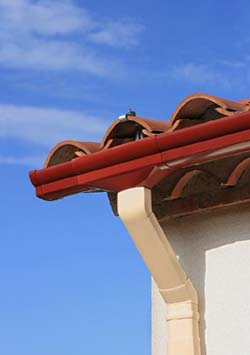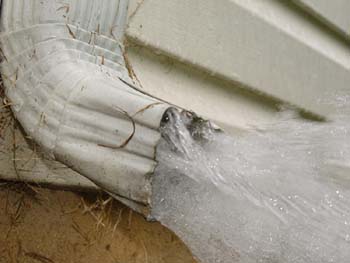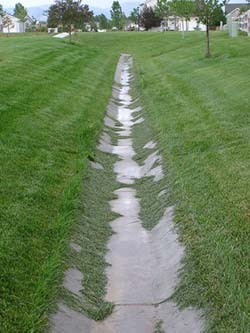
Ideally, the home builder that built your home took all the necessary steps to prevent a drainage problem with your home. Hopefully, your home was built on the “high point” and your yards are sloping away from your home. However, the reality is that many times home builders spend too little effort and/or money on addressing drainage issues such as slope or grade contour. Your home’s lot may be too close or too flat for water to easily flow away from the home. When this is the case, the problem is magnified when large volumes of water flow off the roof and drain next to the base of the home. Unfortunately in these cases, the drainage issues are present from the first day the home was completed and now the homeowner has to fix it. There are a number of problems associated with poor drainage around a home’s foundation. A list of these problems appears below.
Poor Foundation Drainage and Resulting Problems
- Foundation Damage – Excess water will saturate the clay soils around and under the perimeter of the home’s foundation. This will cause extreme expansion of these soils because clay soils expand in volume when wet. The extreme expansion in soil volume around and under the foundation’s perimeter can cause Upheaval, which is a process where part of the foundation is lifted ABOVE its original elevation.
- Interior and Exterior Wall Damage – Upheaval frequently creates cracks on interior and exterior walls. They are very obvious and often occur near door frames and windows.
- Door and Window Problems – Upheaval also results in windows and doors that do not open and close properly.
- Landscaping Damage – Poor drainage can result in damage to landscaping.
- Flooding through Weep Holes – Excess water can pool near the home’s foundation and enter the home through the exterior weep holes. Weep holes are intentionally built into the exterior walls of the home to allow for proper ventilation but when water enters these weep holes in volume the result can be thousands of dollars in damage.
- Mold and Insect Infestation – Excess water that occasionally enters the exterior weep holes in smaller amounts can result in serious problems with mold. In addition, the moist environment is attractive to insects and small mice.
Landscapers can also be co-conspirators with a foundation drainage problem. All too often the landscapers are not trained and they will add soil and plants that actually create water pooling near the foundation and easy water entry into weep holes! Look at your landscaping with a keen eye. Does it slope toward the base of your home? What is the distance between the bottom of the weep holes and the ground? When water does enter the weep holes, landscapers are often the guilty party along with a heavy rain storm.

The Drainage Inspection
- Excessive Soil Moisture near the Foundation – As mentioned earlier on this page, too much water around the perimeter of the home can cause extreme soil expansion, resulting in Upheaval.
- Slope – Does the soil / lawn / landscaping around your home slope AWAY from your home?
- Gutters – Are they present and draining water away from the home? Downspouts also? If not, then all of the rainwater that hits the home’s roof will drain to the base of the home’s foundation. If they are not present then usually the front and back of the home will receive large volumes of water while the sides of the home will receive less.
- Sprinkler System – Is a sprinkler system depositing too much water around the base of the foundation or in other places?
Drainage Solutions
Many homes have a very good drainage system and it is working as designed. However, our representative will make very specific drainage recommendations if they are needed. A good drainage system is important for the long-term maintenance and upkeep of a home or commercial structure. It is even more important in Texas because our clay soils are constantly moving – shrinking in volume when dry and expanding in volume when wet. So it is in the homeowner’s best interest to control water flow with a good drainage system to avoid potential foundation damage from excessive water saturation.
Common Suggestions for a Drainage System
- Regrade (slope) the Exterior Soil
- Install Gutters and Downspouts
- Swale / Channel / Shallow Trench
- Traditional French Drain
- Perforated Corrugated Pipe with Surface Drain
- Corrugated Pipe with Catch Basin

